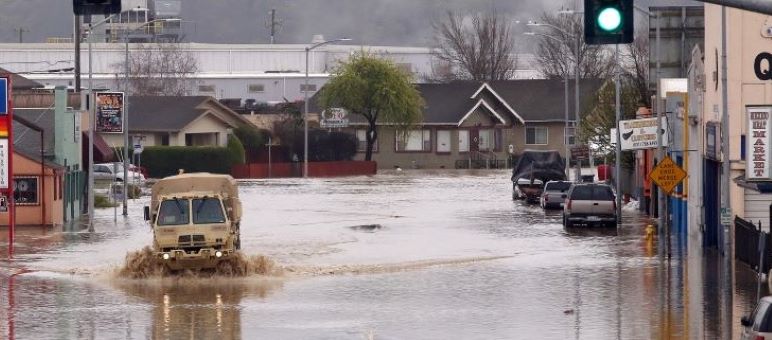It was late Friday morning when muddy, brown water started rushing onto Michelle Hackett’s Salinas Valley farms.
On one side of her family’s Riverview Farms cannabis business, a county-mandated retention pond overflowed. Next door, a farm abandoned by another grower — one of dozens of cannabis businesses to shut down in Monterey County in recent years — spawned another small river headed straight for Hackett and her skeleton crew.
“The water completely stopped and backed up,” Hackett said. “I thought, ‘Holy s***, this is going to flood our greenhouses.’”
Cannabis businesses like Hackett’s — along with thousands of undocumented farmworkers and the area’s unhoused residents — fear they’ll be left to fend for themselves as yet another winter storm batters California’s Central Coast, local officials and advocates say.
Undocumented workers and cannabis businesses are, by law, ineligible for federally funded programs such as unemployment or aid from the Federal Emergency Management Agency.
Now — after days of wind and rain and a Pajaro River levee failure flooded the area, displacing hundreds of people in Monterey County alone — details are lacking about how state officials would respond to calls to direct state funds and other disaster relief to these communities in the region known as America’s salad bowl.
California has stepped into the breach before, offering some support to undocumented workers during the height of the COVID-19 pandemic, and to some cannabis farmers whose crops were damaged in wildfires.
It’s an issue complicated by competing political priorities and a projected $24 billion state budget deficit for the coming year.
While touring flooded regions, including the inundated farmworker town of Pajaro, Gov. Gavin Newsom said that $42 million is available from the United Way for emergency payments to farmworkers, regardless of immigration status. He said the nonprofit will start sending out $600 checks as requested.

Hundreds of families were evacuated in the community of Pajaro.
Photo by Tarmo Hannula, San Jose Inside
“Those dollars will start going out today,” Newsom said. The funds come from a grant announced in October by the U.S. Department of Agriculture to provide economic relief to farmworkers and their families .
He noted that undocumented workers typically are ineligible for federal aid because they are in California without federal authorization. Newsom voiced appreciation for the nonprofits that have stepped in to fill the gaps.
“There are a lot of people here that are not immediately eligible for assistance, folks out here that we’re very mindful of,” he said. “There’s not a state in America … that does more for farm workers than the state of California. And we don’t do enough.”
The governor said officials are working to assess damage and update the state of emergency designations — an essential step to attracting more government dollars to the recovery effort.
Long before the storm, the federal government and California had been planning a levy improvement project for the region. It is expected to take five to seven years, but Newsom said today he is urging the Army Corps of Engineers to speed up their timeline and to put higher priority on levy projects affecting vulnerable, low-income communities.
The governor did not provide details about how the state might help cannabis farms, which also are ineligible for federal funds.
As Newsom planned his visit, many officials and advocates said they hope to hear how the state will help. A few lawmakers said they’re exploring legislative options.
“I think we need to step up our efforts to help those who are undocumented and can’t earn a paycheck because of the current rains and floods,” said Assemblymember Miguel Santiago, a Democrat representing Los Angeles.
He is co-sponsoring Senate Bill 227 to provide unemployment benefits to undocumented Californians. About 6 in 10 farmworkers are not eligible for unemployment benefits, according to studies.
Santiago said the current situation is frustrating because he has advocated for years for more safety net programs that could have helped families hurt by the flooding. If such legislation was in place, he said, “we’d be able to have a place where we could go get people some financial relief.”
Assemblymember Robert Rivas of Salinas, chosen by his fellow Democrats to be the next Assembly Speaker, noted in a statement to CalMatters that undocumented workers typically don’t qualify for federal assistance funds for emergency housing, home repairs, personal property loss, funeral expenses and other aid.
“My office, in collaboration with other legislative offices, is exploring immediate legislative and budget action to provide relief for these vulnerable communities,” Rivas said, noting that the workers also had been ineligible for many COVID-19 relief programs.
The state began filling some of that gap during the pandemic. Undocumented workers were eligible for $1,700 in state funds: a $500 COVID-19 Disaster Relief prepaid card and $1,200 from the Golden State Stimulus Fund.
Tuesday afternoon, groups of people remained in tents along the flooded Pajaro River. Despite large federal and state housing budgets, many of those people don’t have homes.
Many farmworker families in the flooded region are undocumented, from indigenous groups, and don’t speak either English or Spanish well, said Eloy Ortiz, a board member for the Watsonville-based Center for Farmworker Families.
That complicates attempts to apply for assistance on behalf of the legal residents in their household. Some were rejected when they applied for aid in January, Ortiz said.
“The folks who have been flooded out, if it were a normal year, they’d be starting to go back to the fields to work right now,” Ortiz said. “And now they will probably not be able to go back for months.”
More than 20,000 acres of agricultural land in Monterey County will likely sit fallow because of stormwater contamination, noted Monterey County Supervisor Luis Alejo, a former Assembly member from Watsonville, in a tweet.
“These are low-income Latino families, and the start of the harvest season for strawberries, raspberries and other crops is in March. Now farmworkers will be out of work,” he wrote Tuesday.
“I urge our state leaders to provide aid in the state budget for undocumented flood victims who do not qualify for FEMA assistance & additional relief for farmworkers who will be out of work due to flooded ag fields and not qualifying for unemployment insurance,” he wrote.
“The financial pain they will face will be severe & prolonged!”
As many as 8,500 people were under flood evacuation warnings in Monterey County over the weekend. The California Governor’s Office of Emergency Services reported more than 300 people had stayed in five shelters across Santa Cruz and Monterey Counties Monday night, the vast majority taking shelter at the Santa Cruz County Fairgrounds.
In Salinas, Hackett, 32, said her choice was simple as the storm bore down: save herself, or say goodbye to a crop that has already weathered a steep drop in prices and other industry pressures. At least 56 cannabis businesses have closed in Monterey County in recent years, according to a recent estimate.
As the water rose Friday morning, Hackett and her team that normally would be busy trimming plants or readying retail products instead shut down early to reinforce storm ditches and forge cement slabs into an impromptu flood wall.
On Tuesday, as another storm knocked out power at her two adjacent 10-acre farms, Hackett said she is unaware of any aid available for cannabis businesses impacted by flooding.
“Ideally if we were any other business, we would have immediately had help,” Hackett said. “Whether it be the county, whether it be the state — someone needs to be held accountable.”
Longer term, Hackett said she fears climate change and economic obstacles will point her industry toward the same downward trajectory that wiped out many of the flower growers who once thrived in the same Monterey County greenhouses.
She isn’t alone in her frustrations.
Joey Espinoza, a Salinas-raised cannabis compliance consultant, said several of his clients were directly impacted by floodwaters, including one grower who had to evacuate plants from a flooded greenhouse. Even while the ground was still muddy, he said, many cannabis farmers have turned their attention to other pressing challenges in the industry.
As cannabis remains illegal at the national level, Espinoza said, local growers shut out of federal financial aid are now confronting storm damage after a collapse in cannabis prices and while facing a tight deadline to apply for new state licenses by the end of the year.
Industry advocates say the economic turmoil stems from a mix of overproduction of legal and illegal cannabis, as well as ever-changing taxes and regulations.
“There’s layers of issues with all of this,” Espinoza said. “And the thing to remember is, there’s not gonna be a lot of relief for cannabis in terms of FEMA and things like that.”
It was unclear exactly what the state might do.
The California Department of Cannabis Control told CalMatters that, under current state law, cannabis businesses impacted by disasters may apply for temporary waivers of license requirements if they become unable to meet regulatory requirements. State licensing rules govern everything from sometimes-costly infrastructure requirements to the way products are transported and secured.
“All requests are reviewed on a case-by-case basis and aim to provide regulatory relief to licensees for impacts related to issues including flooding,” ” said David Hafner, department spokesperson.
In the past the department has offered support for cannabis growers impacted by wildfires.
Few lawmakers voiced ideas.
In the meantime, some residents took matters into their own hands.
Gabino Orozco Avila was getting ready to serve dinner to neighbors gathered on a walkway above the rushing Pajaro River late Tuesday afternoon, a stone’s throw from his daughter’s home in Pajaro. While his daughter remained evacuated, Avila, owner of a longtime food business, Tacos Los Jacona — a nod to his Michoacán hometown — had prepared carne asada, rice and beans for the community that had long supported him.
“Now that people need me,” he said in Spanish, “I’ll be here.”
Lauren Hepler, Nicole Foy and Wendy Fry are reporters with CalMatters.


Newsom is the worst Governor in the history of California.
David S. Wall
3000 Pajaro residents times $600 is $1.8 million, probably less than Newsom’s Plumpjack wine store got from the SVB bailout he lobbied Biden for.